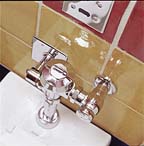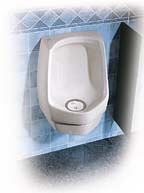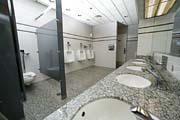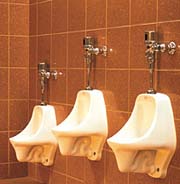But now manufacturers have made the necessary changes to supply the industry with low-consumption, high-performance products. With the introduction of better performing low-flow fixtures, a new "green" influence has emerged: quicker returns on investment.
With the rising cost of water and sewage-which now averages approximately $4 per 1,000 gallons and is expected to rise at a pace 2% greater than inflation-"green design" may well stand for money saved, as well as saving the environment.
In fact, California's Sustainable Building Task Force released a 134-page report titled, "The Costs and Financial Benefits of Green Buildings," which confirms the economic viability of "green buildings" as an investment. The report states that an increase in overall building costs of 2% will, on average, achieve a life-cycle savings of 20% of the total investment-10 times the initial additional cost.

Creating Environmental Awareness
One of the major forces that has created environmental awareness for the building industry is the LEED® Green Building Rating System. LEED has become the most influential driver for green buildings. This system helps project teams determine environmental goals, identify green design strategies, measure and monitor progress and document success.A product of the United States Green Building Council, LEED provides a menu of green building measures in five categories:
There is also a category on Innovation and Design Process, which addresses design measures not covered in the other five categories.
One of the simplest ways to earn LEED credits is by surpassing the standards set for Water Efficiency, which means reducing water consumption by 20% or 30% beyond the Energy Policy Act of 1992 standards.
Water Efficiency measures in commercial buildings can easily reduce water usage by 30% or more, and as costs for potable water continue to escalate, this area can impact the bottom line in ways it never has in the past. In a typical 100,000-sq.-ft. office building, low-flow fixtures coupled with sensors and automatic controls can save a minimum of one million gallons of water per year, based on 650 building occupants each using an average of 20 gallons per day. Currently, the standard toilet fixture uses 1.6 gallons per flush (gpf) (6 liters) and the standard urinal consumes 1.0 gpf (3.8 liters). Design strategies using 0.5 gpf (1.9 liters) urinals, as well as waterfree urinals, can impact usage and maximize water savings. Ultra low-flush toilet fixtures that use less than the standard 1.6 gpf are also available.
To attain the highest possible LEED rating, all water-consuming fixtures should be selected for their ability to conserve water and provide durability for long-lasting service. The more a product can maintain the habits of a population while conserving energy, the more the product will be accepted. For example, low-flow urinals and 0.5 gpf urinals reduce water consumption without requiring a habit change on the part of users. In both cases, the systems contribute to a LEED certification goal while being used in the manner in which people are accustomed.
Measures taken to achieve Water Efficiency objectives can overlap into other LEED categories too. Knowing the products and understanding the intent of the LEED criteria can accomplish maximizing point-earning potential. For example, low-flow urinals contribute in achieving Water Efficiency goals. Additionally, the same product may be manufactured from recycled content, as well as being regionally manufactured (within a 500-mile radius of the project site)-both of which can contribute in achieving multiple Materials Resources points.
Another advantage of earning a LEED certification is the accompanying positive press, because LEED now represents a building's elite status, which allows owners to operate these choice properties most economically while justifying market-level rents to tenants.

Evolving Plumbing Fixtures
The demand and overuse of water in the United States affects regional water quality. As a result, prudence dictates plumbing engineers can no longer assume water is homogeneous. Engineers must consider the quality of local supplies when writing their specifications for flushing technologies.While federal laws have established standards for water quality, there are still wide quality ranges because states have the authority to control their own water treatment systems. This means each state approves, prohibits or limits the use of chemicals in public water supplies and how water is purified, resulting in varied particulate and trace element levels. To complicate matters further, individual municipalities each have their own "art of processing water."
This checkered water quality forces plumbing fixture manufacturers to produce products that will function in the most extreme environments. To accomplish this, manufacturing design engineers must anticipate "worst case design scenarios" and design products to withstand the varying quality of water that flows through pipes from Seattle to Sarasota.

Chloramine Effects on Plumbing Components
National Primary Drinking Water Regulations are legally enforceable standards that apply to public water systems in the United States and were developed to protect public health by limiting the levels of contaminants in drinking water.To meet these standards, water treatment plants began using chloramines that act as a disinfectant during the treatment process. While consumption of these disinfectants in low levels will not cause illness, Chloramines can cause harm to some materials in plumbing devices. In other situations, concentrated chlorine is added to the water supply for short periods (i.e., during flushing of hydrants or maintenance on water mains). This can also affect some materials in plumbing devices.
Chart 1: Disinfectants - National Primary Drinking Water Regulations
Contaminant Maximum Residual Disinfectant Level
Chloramines (as Cl2) MRDL = 4.0
Chlorine (as Cl2) MRDL = 4.0
Chlorine dioxide (as ClO2) MRDL = 0.8
Units are in milligrams per liter. Milligrams per liter are equivalent to parts per million. Source: http://www.epa.gov/safewater/mcl.html.
Consequently, plumbing fixture manufacturers in America developed new synthetic rubber materials and engineered plastics that could withstand constant exposure to these and other chemicals for their products. In general, plumbing fixture manufacturers now use plastics and elastomers for some critical water-exposed parts because they provide specific mechanical, physical and anti-corrosive properties.
High-Copper/Low-Zinc Brass
Until the mid-1900s, red brass was the most common metal used for plumbing fixtures because it was easily machined and resistant to corrosion. However, the cast form of red brass became too expensive for the market.Pressure from the construction industry and cost conscientiousness led manufacturers to begin using high-zinc wrought alloys (mostly manganese brass) that provided additional mechanical strength and allowed production of valves with smaller diameters.
Manganese brass, which contains approximately 35% zinc, immediately proved to reduce cost and improve valve performance, but over time, these alloy valves became brittle in corrosive water conditions. Effectively, the highly reactive zinc was chemically leached out, leaving a porous, copper-rich metal shell, because zinc atoms are easily given up to solutions with high chloride ion content and other aggressive chemicals.
By the 1950s, the dezincification problem was identified, and plumbing fixture manufacturers began using high-copper/low-zinc alloys known as silicon brass, which contains between 12%-16% zinc. Using this new alloy alleviated the dezincification problem in the U.S. for several decades, until a flux of imported valves containing a zinc content of 18% or more reintroduced the problem in North America.

Other Factors to Consider
Factors such as the type of facility and the number of people who will have access to specific restrooms must be considered when choosing flushing technologies. Another consideration is hygiene and user comfort, which directly affect the building in terms of tenant satisfaction and occupancy rates.As a general rule, for more aesthetically demanding installations that must withstand public use by many users, specifying vandal-resistant electronic flushometers is the most effective solution. For restrooms that will handle lighter traffic, manual flushometers provide the same level of performance as electronic models, but require hand activation, increasing chances for abuse, non-flushing and reduced hygiene.
For close to a century, flushometers have been used in every type of building due to the ability to precisely meter water and recycle quickly for consecutive users. The evacuation of the fixture is powerful, providing a scouring action that ensures thorough cleansing for maximum hygiene and reduced maintenance. Low-consumption water closet flushometers consume up to 1.6 gpf, while ultra low-consumption urinals use 0.5 gpf. However, engineers must be careful in their selection, as some flushometers allow external adjustment of the amount of water used to flush, which can negate the conservation effects.
Conveniently, some flushometers do not require water flow adjustment at installation because they are engineered to deliver the same amount of water over a broad pressure range. That means a proportionate amount of water flows through the valve, which is typically controlled by a bypass orifice, regardless of the pressure range. A constant amount of water passes through the valve, so that the volume of water delivered is the same for each operation.
Retrofit Applications
As building owners choose to reinvest in existing structures, plumbing retrofits are becoming more attractive to allow for accessibility, provide increased hygiene and decrease water consumption.The advantage of retrofitting old flushometers is that products have vastly improved in terms of quality and efficiency. There have been advancements in electronic products, whereby the solenoid, which initiates the flushing sequence, is isolated from the water source for more reliable operation. There are also generational improvements to sensor technology, which can now identify users more consistently, ensuring a single flush per use instead of multiple, which waste water, or no flush because the user was not recognized.
While older flushometers can use more than five gallons a flush, waterfree urinals, which connect directly to existing drainlines for simple retrofit applications, consume no water to maximize conservation efforts without sacrificing hygiene. Waterfree urinals use a liquid-sealed cartridge to form a barrier between the open air and urine, which prevents any odors from escaping from the drainline. These special cartridges filter sediment from the urinal, allowing the remaining liquid to pass freely down the drain, providing an odor-free environment.
Other retrofit options include upgrades of manual units into touchless models with kits that flush electronically. Both side-mounted and integral top-load modules are available and provide the same advantages of new, touchless products that are "right out of the box."
By keeping operating costs in mind and focusing on traffic patterns that must be accommodated, plumbing engineers can retrofit economically, achieving many of the same standards as new constructions. For more information on water-conserving fixtures, visit Sloan Valve Company's website at www.sloanvalve.com.
SIDEBAR: No "Roughing It" at The Wilderness
When The Wilderness Hotel and Golf Resort first opened in June of 1995, it had only 79 rooms, each with traditional 1.6-gallon gravity toilets. However, management quickly learned that these toilets caused too many problems for the family-oriented resort.So, Brian Purdy, building systems & aquatic director for the largest indoor/outdoor waterpark resort in America, knew he needed to change out the toilets to keep the expanding resort, which now has 443 rooms, running at optimum level.
He decided to install low-consumption, highly functional FLUSHMATE®-equipped toilets so his crew could apply their time toward other matters than plugged toilets.
"Obviously, no one wants to deal with a stopped-up toilet," says Purdy. "Each call for something like that takes at least 10 to 15 minutes for one of our staff to take care of. That's not a wise way to spend our time when we have other projects to work on, especially considering our growth since first opening. Besides, our guests are here to relax, not deal with such inconveniences."
As the resort grew and an additional 60 rooms were added in 1999, the owners knew that FLUSHMATE pressure-assist toilets were needed to provide the best possible atmosphere for guests.
"The original phase was built with gravity toilets, and those just weren't up to snuff," Purdy explains. "When we installed FLUSHMATES, they made a great difference in the number of calls we received about toilets. Very seldom do we get a call about a FLUSHMATE toilet."
Situated on 310 acres of pristine pineland in the Wisconsin Dells, The Wilderness Hotel and Golf Resort features an 18-hole championship golf course, a six-hole "Little Links" course, three indoor waterparks, two outdoor waterparks and a three-story, dry foam play area designed for all-ages fun. With plans for additional construction, Purdy sees no reason to fix what is not broken.
"We've been able to cost-effectively install FLUSHMATE toilets, and our experience with them has been great," Purdy says. "We're now planning for Phase III at the Wilderness, and we'll incorporate FLUSHMATES into the new rooms. And anything else we build will have them too."
For more information on FLUSHMATE pressure-assist toilets, visit FLUSHMATE, a division of Sloan Valve Company, online at www.flushmate.com.